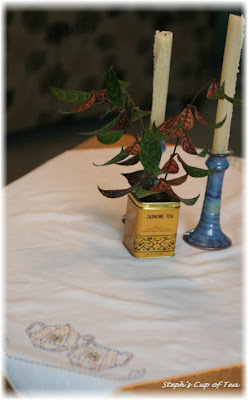Chinese Huangshan Maofeng tea
Photo taking during the Asia Tea Tour
Photo taking during the Asia Tea Tour
Green tea is diverse! From sweet to tart, mellow to brisk, nutty to roasty, grassy to vegetal, twisted to flat to rolled to hand tied, I believe there is a green tea for everyone. Truly, there is an entire world of green tea for you to try! The fun comes in finding the ones you love.
The two basic categories of green tea are Chinese and Japanese, though you'll find most tea-producing countries making green teas. In fact, it's green tea that most of the world knows, loves and drinks.
Chinese Green Tea
China has been producing green teas for over 5,000 years! Chinese greens are a good place to start if you're just venturing into the world of green tea. They're milder, sweeter and less likely to make you pucker on first sip.
Chinese green teas are picked and then heated to stop the oxidation and preserve the chlorophyll. (This process is called "fixing" the tea.) There are myriad of ways to fix the tea, but common techniques include heating in a wok, in bamboo baskets over charcoal, or in heated ovens. The amount of variation within Chinese green tea is staggering - taste, appearance, aroma. There are thousands of small batch tea makers, each with his or her own technique.
Famous Chinese green teas include: Dragonwell, Gunpowder, Bi Lou Chun, and Huangshan Maofeng (shown above).
Chinese Beauty Rings
An example of beautiful hand shaping
An example of beautiful hand shaping
Japanese Green Tea
Japanese green teas are well known for the bright jade liquor produced in the cup, with a bit of sediment at the bottom. This sediment is intentional, nothing is wasted. The particulate is added back into the leaf to give it a brothy essence.
Japanese greens are steamed to fix the leaves and then shaped (this can have several cycles) and finished in a hot oven. Most of the picking and processing of teas in Japan is mechanized. Don't let that turn you off; it's just how it's done in Japan.
Famous Japanese green teas include: Sencha, Bancha, Gyokuro and Matcha. (We'll look at matcha separately.)
Many Chinese and Japanese greens never make it to our shores. They are swooped up by local consumption, and increasingly, in-country connoisseurs. But don't despair - there are many, many available to us and if you tried to taste them all, you would find a major undertaking!
Many Chinese and Japanese greens never make it to our shores. They are swooped up by local consumption, and increasingly, in-country connoisseurs. But don't despair - there are many, many available to us and if you tried to taste them all, you would find a major undertaking!
Buy green teas in small quantities and drink them up quickly. They don't keep as long as oolong and black teas will, due to a higher moisture content. I prefer to drink mine within 3 months ideally, 6 on the outside.
I tend to brew my green teas - both Chinese and Japanese - in a gaiwan, but you can also use a teapot. Use water between 160 and 180 degrees, and start tasting quickly. I find the window for most greens to be between 1 and 3 minutes.
What are your tips for greens? Or your favorite green teas?


























